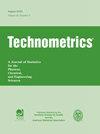海量数据的高效无模型子抽样方法
IF 2.5
3区 工程技术
Q1 STATISTICS & PROBABILITY
引用次数: 0
摘要
摘要子抽样在解决海量数据集的存储和统计学习问题中起着至关重要的作用。然而,大多数现有的子采样方法都是基于模型的,这意味着当底层模型被错误指定时,它们的性能会显著下降。这样的问题需要在各种模型规范下具有鲁棒性的无模型子采样方法。近年来发展了几种无模型子抽样方法。然而,这些方法的计算时间随着样本量的增长呈爆炸式增长,使得它们在处理海量数据时不切实际。本文提出了一种有效的无模型子采样方法,该方法将原始数据分割成规则的数据块,通过数据驱动的子采样方法从每个数据块中获取子样本。与现有的无模型子采样方法相比,该方法具有显著的速度优势,并且对于底层分布复杂的数据集具有更强的鲁棒性。仿真实验表明,当原始数据集的样本量达到107数量级时,该方法比其他常用的无模型子采样方法快一个数量级。仿真实验和实例研究表明,在不同的模型规格和子样本量下,该方法比其他无模型子抽样方法具有更强的鲁棒性。关键词:大数据子采样模型鲁棒性并行计算统一设计免责声明作为对作者和研究人员的服务,我们提供此版本的已接受稿件(AM)。在最终出版版本记录(VoR)之前,将对该手稿进行编辑、排版和审查。在制作和印前,可能会发现可能影响内容的错误,所有适用于期刊的法律免责声明也与这些版本有关。本文章由计算机程序翻译,如有差异,请以英文原文为准。
Efficient Model-free Subsampling Method for Massive Data
AbstractSubsampling plays a crucial role in tackling problems associated with the storage and statistical learning of massive datasets. However, most existing subsampling methods are model-based, which means their performances can drop significantly when the underlying model is misspecified. Such an issue calls for model-free subsampling methods that are robust under diverse model specifications. Recently, several model-free subsampling methods are developed. However, the computing time of these methods grows explosively with the sample size, making them impractical for handling massive data. In this paper, an efficient model-free subsampling method is proposed, which segments the original data into some regular data blocks and obtains subsamples from each data block by the data-driven subsampling method. Compared with existing model-free subsampling methods, the proposed method has a significant speed advantage and performs more robustly for datasets with complex underlying distributions. As demonstrated in simulation experiments, the proposed method is an order of magnitude faster than other commonly used model-free subsampling methods when the sample size of the original dataset reaches the order of 107. Moreover, simulation experiments and case studies show that the proposed method is more robust than other model-free subsampling methods under diverse model specifications and subsample sizes.Keywords: Big data subsamplingModel robustnessParallel computingUniform designsDisclaimerAs a service to authors and researchers we are providing this version of an accepted manuscript (AM). Copyediting, typesetting, and review of the resulting proofs will be undertaken on this manuscript before final publication of the Version of Record (VoR). During production and pre-press, errors may be discovered which could affect the content, and all legal disclaimers that apply to the journal relate to these versions also.
求助全文
通过发布文献求助,成功后即可免费获取论文全文。
去求助
来源期刊

Technometrics
管理科学-统计学与概率论
CiteScore
4.50
自引率
16.00%
发文量
59
审稿时长
>12 weeks
期刊介绍:
Technometrics is a Journal of Statistics for the Physical, Chemical, and Engineering Sciences, and is published Quarterly by the American Society for Quality and the American Statistical Association.Since its inception in 1959, the mission of Technometrics has been to contribute to the development and use of statistical methods in the physical, chemical, and engineering sciences.
 求助内容:
求助内容: 应助结果提醒方式:
应助结果提醒方式:


